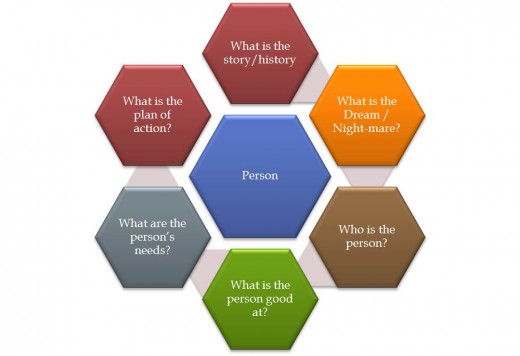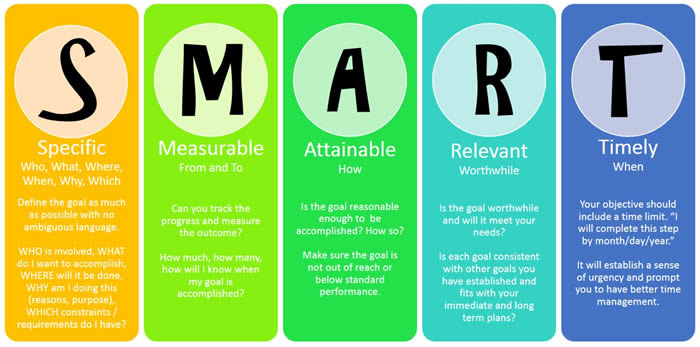Lesson 3: Motivational Interviewing and Treatment Planning
Attention

While this graphic does not represent Motivational Interviewing it does outline the steps in Treatment Planning that align very nicely with the steps in Motivational Interviewing.
We will be merging these two models to develop a set of expectations for your practice in this course and beyond.
Learning Outcomes
Upon completion of this lesson's material, students will be able to:
- Provide personal examples of goal setting using the terminology associated with goal setting.
- Integrate the steps of Motivational Interviewing with the steps in defining and implementing a Treatment Plan.
- Write an effective S.M.A.R.T. goal.
Teaching
Motivational Interviewing
Review p. 8 in the CCNC Motivational Interviewing (MI) Resource Guide.
The basic steps in the MI process are as follows:
- Engaging - Empathic Listening
- Focusing - Targeting Change
- Evoking - Client's Ideas
- Planning - Getting to Change
Each of these will be covered in detail later in the course but I think it is important to see how these skills integrate into the Treatment Planning process that you will be engaged in all the time.
Treatment Planning Process
When you meet a client for the first time you often have a sense of what might be going on based on the referral information. However, despite the fact that you may already have a good sense of what you are going to do, it is vital that you go through each step of the process in order to be most effective
The basic steps in the Treatment Planning process are as follows:
- Build the Relationship - Establish rapport through questions and conversation.
- Identify Problems / Assessment - Establish a good sense as to how the client sees the problem or problems.
- Get the Story - You want to get as much background on the problem as you can, including the history of the problem and previous efforts to solve the problem. This is also where we can identify strengths and resources that the person has.
- Identify Barriers - Barriers are the circumstances that are in the way of "fixing" the problem, or accomplishing the goal. Some barriers are exterior to the person (money, transportation, perception of people with mental illness) while others are internal to the person (personal motivation, lack of skills, behavioral challenges).
- Goals - Goals focus the individual on the picture of where they want to be...what do they want life to look like once they have accomplished the goal? Complex, multi-step goals can be divided into sub-goals or steps.
- Planning - Our plans, in nearly every regard, focus on linking our clients to the services they need to solve the problem or accomplish the goal. These should be based in reality, should identify the person or persons responsible for the goal, and should provide a time frame for periodic review and accomplishment.
- Review - The overall plan of someone should be reviewed, re-assessed, and re-written on a regular basis. Our world changes, so do our goals.
This is actually a CIRCULAR process best represented by the figure in the Attention section of this Lesson Plan!

Can you see how there is tremendous overlap between these two models. We will be engaged in BOTH of these models through the course.
S.M.A.R.T. Goals
Finally, as we are going to be connecting all of our work to the goals of a client, we need to be able to write goals in a professional way. One of the best models used to write goals is defined by the acronym S.M.A.R.T.

If you click on the image above a larger version will open up that is easier to read!
As you work through this class the goals that you write will be evaluated using the S.M.A.R.T. formula.
Assessment

Lesson 3 Assignment A
In this assignment I would like you to create a document. The document should present, in some way, your understanding of the interrelation between the Motivational Interviewing steps and the Treatment Planning steps.
This document could be a paper, a slide show, or even a presentation like the one in Lesson 3 Discussion. Your choice. SHOW me that you can see how these two models work well with each other.
Lesson 3 Quiz
- Choose a goal that you have in your life right now that you REALLY want to accomplish. Write the goal out using the S.M.A.R.T. method. You will be able to do this quiz a few times to perfect this process so you will need to read the Faculty feedback each time you do it until you get it perfect.
Lesson 3 Discussion
In this discussion I would like each of you to post an example of a goal that you have personally accomplished in your life. Describe the goal attainment using the same terminology that is used in this Lesson Plan.
To tell the story of your goal attainment you are going to use your iPad to create a visual story! Your story will include text, pictures, graphics, and pictures, along with your voice telling us the story. Check out the iPad Integration box below for more information.
Adobe Spark Video is a FREE app from the makers of Photoshop...Adobe.
Once you download this app you will be asked to create an account. This account allows you to create and store as many videos as you want! You use the app to create stories through text, images, pictures, etc. and then you can add your voice to narrate the story! When you have edited your story perfectly, Adobe Spark Video will provide you with a link directly to your video on the web that you can post anywhere...including in a Discussion Board. Post the link to your story in the Discussion Board for this Lesson! |

